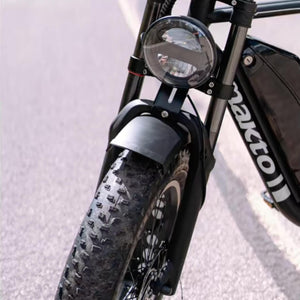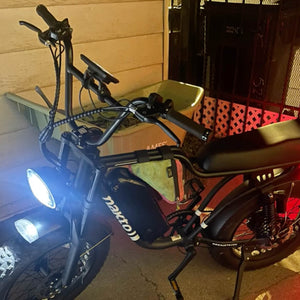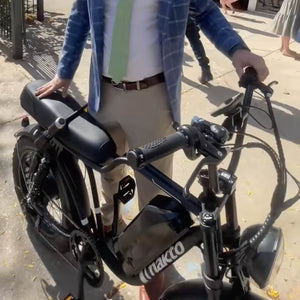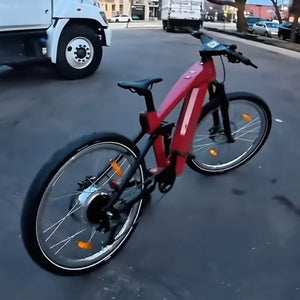Understanding E-Bike & Scooter Classes – What Do They Mean?
Feb 19, 2025
Introduction
Not all e-bikes and electric scooters are the same. If you’re new to personal electric vehicles (PEVs), you may have noticed that e-bikes are categorized into Class 1, Class 2, and Class 3. Understanding these classifications is crucial for choosing the right ride and ensuring compliance with local laws.
This guide will break down the different classes of e-bikes and discuss how electric scooters fit into the equation. Whether you're commuting, riding for fun, or considering an upgrade, knowing these differences will help you make the right decision.
E-Bike Classification Explained
E-bikes are categorized into three classes based on their speed, motor assistance, and legal restrictions. While laws vary by state or country, these classes provide a general framework for how e-bikes are regulated.
Class 1: Pedal-Assist Only, Max 20 MPH
- Motor Assistance: Engages only when the rider pedals
- Maximum Speed: 20 mph before assistance stops
- Throttle: Not available
- Legal Use: Generally allowed on bike paths, bike lanes, and public roads
Class 1 e-bikes are the most widely accepted and have the least legal restrictions. Since they rely on pedal power, they are a great choice for riders who want an electric boost but still prefer traditional cycling. Many cities and trail networks allow Class 1 e-bikes wherever regular bicycles are permitted.
Class 2: Throttle & Pedal-Assist, Max 20 MPH
- Motor Assistance: Works with both throttle and pedal-assist
- Maximum Speed: 20 mph before assistance stops
- Throttle: Yes, can operate without pedaling
- Legal Use: Permitted in most areas where Class 1 e-bikes are allowed, but some trails may restrict them
Class 2 e-bikes offer a throttle, which means riders can travel at speed without pedaling. This makes them an excellent option for those who need mobility assistance or want a more relaxed riding experience. However, some locations impose stricter regulations on throttle-powered bikes, so it’s important to check local laws.
Class 3: Pedal-Assist Only, Max 28 MPH
- Motor Assistance: Engages only when the rider pedals
- Maximum Speed: 28 mph before assistance stops
- Throttle: Not available
- Legal Use: Allowed on roads and some bike lanes, but usually restricted from multi-use paths and sidewalks
Class 3 e-bikes are designed for speed and efficiency, making them ideal for commuting and urban transportation. Because they can reach higher speeds, many states require helmets and additional safety precautions. Some cities prohibit them from using regular bike paths, so be sure to review your local regulations.
How Electric Scooters Fit Into the Equation
Unlike e-bikes, electric scooters do not have a universal classification system, but they are typically categorized by their top speed and motor power. Many regions divide them into the following categories:
Low-Speed Scooters (Under 15 MPH)
- Commonly permitted on sidewalks and bike lanes
- No registration or insurance required in most areas
- Designed for urban travel and short distances
Mid-Speed Scooters (15-25 MPH)
- May require riding on streets instead of sidewalks
- Some areas impose helmet laws for riders
- Typically used for commuting and city transportation
High-Speed Scooters (Over 25 MPH)
- Considered motor vehicles in many locations
- May require registration, insurance, and a valid license
- Used for long-distance travel and high-performance riding
The lack of a universal scooter classification means laws vary widely. Always check local regulations before purchasing or riding an electric scooter.
Which E-Bike or Scooter Class is Best for You?
The best choice depends on your riding style, local laws, and how you plan to use your PEV.
- Commuters: Class 2 or Class 3 e-bikes offer the best speed and convenience for daily travel.
- Casual Riders: Class 1 e-bikes provide a balance of exercise and electric assistance.
- Long-Distance Riders: Class 3 e-bikes or mid-speed electric scooters allow for faster travel.
- Urban Riders: Electric scooters in the 15-25 mph range work well for city streets.
For riders who want more flexibility, a Class 2 e-bike allows both pedal-assist and throttle control, making it a versatile choice for mixed riding conditions.
Legal Considerations and Safety Requirements
E-Bike Laws by Class
- Class 1 & 2 e-bikes are permitted in most bike lanes and trails.
- Class 3 e-bikes are often restricted from multi-use paths and may require helmets.
- Speed restrictions vary by state, so always check local laws before riding.
Scooter Regulations
- Many cities limit electric scooters to road use only, banning them from sidewalks.
- Helmets may be required for riders under a certain age.
- High-speed scooters may require registration and insurance.
Before purchasing an e-bike or scooter, review the laws in your area to avoid fines and ensure compliance.







